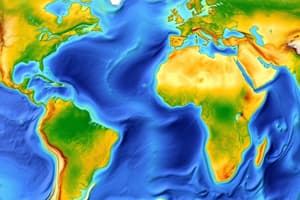Podcast
Questions and Answers
What is the primary measurement method for sea surface temperature that utilizes technology from space?
What is the primary measurement method for sea surface temperature that utilizes technology from space?
- Ship-Based Measurements
- Buoys
- Satellite Remote Sensing (correct)
- Oceanographic Surveys
How does sea surface temperature influence marine ecosystems?
How does sea surface temperature influence marine ecosystems?
- It has no significant impact on biodiversity.
- It affects the distribution of marine species. (correct)
- It controls the depth of ocean thermoclines.
- It dictates the salinity levels of the ocean.
Which phenomenon causes short-term fluctuations in sea surface temperature?
Which phenomenon causes short-term fluctuations in sea surface temperature?
- Global Cooling
- El Niño and La Niña (correct)
- Thermocline Effects
- Ocean Acidification
Which of the following is a key indicator of climate change related to sea surface temperature?
Which of the following is a key indicator of climate change related to sea surface temperature?
What role does upwelling play in sea surface temperature changes?
What role does upwelling play in sea surface temperature changes?
Flashcards are hidden until you start studying
Study Notes
SST (Sea Surface Temperature)
-
Definition: The temperature of the upper layer of the ocean's surface, typically measured in degrees Celsius (°C).
-
Importance:
- Influences weather and climate patterns.
- Affects marine ecosystems and biodiversity.
- Impacts hurricane formation and intensity.
-
Measurement Methods:
- Buoys: Floating devices equipped with sensors to record temperature.
- Satellite Remote Sensing: Uses infrared radiation to measure sea surface temperatures from space.
- Ship-Based Measurements: Data collected from oceanographic research ships.
-
Variability:
- Seasonal changes due to solar heating and ocean currents.
- Short-term fluctuations caused by phenomena such as El Niño and La Niña.
-
Applications:
- Climate monitoring and modeling.
- Weather forecasting.
- Fisheries management and marine resource assessment.
-
Related Concepts:
- Ocean Currents: Influence heat distribution across oceans.
- Heat Capacity: Water's ability to absorb and retain heat affects SST.
- Global Warming: Rising SST is a key indicator of climate change.
-
Key Terms:
- Thermocline: The layer in the ocean where temperature changes rapidly with depth.
- Upwelling: The rising of cold, nutrient-rich water to the surface, affecting local SST.
-
Current Trends:
- Increasing SST observed globally due to climate change.
- Impacts on coral reefs and marine species distributions.
Definition and Importance of SST
- Sea Surface Temperature (SST) refers to the upper layer temperature of the ocean, commonly measured in °C.
- Vital for understanding weather and climate, influencing patterns such as precipitation and storm formation.
- Affects marine ecosystems, biodiversity, and the health of fish stocks.
- Plays a crucial role in hurricane development; higher SST can lead to more intense storms.
Measurement Methods
- Buoys: Utilize sensors to gather temperature data while floating on the ocean's surface.
- Satellite Remote Sensing: Employs infrared radiation to measure SST from orbit, providing broad spatial coverage.
- Ship-Based Measurements: Conducted by oceanographic research vessels, offering high-accuracy temperature readings.
Variability in SST
- Experiences seasonal variations due to factors like solar heating and oceanic currents.
- Short-term changes often linked to climatic phenomena such as El Niño (warmer SST) and La Niña (cooler SST).
Applications of SST Data
- Essential for climate monitoring and predictive modeling in environmental studies.
- Contributes significantly to weather forecasting accuracy, impacting daily life and disaster preparedness.
- Crucial for managing fisheries to ensure sustainable marine resources and protect livelihoods.
Related Concepts
- Ocean Currents: Distribute heat across oceans, thus affecting SST patterns locally and globally.
- Heat Capacity: Water’s high heat capacity enables it to absorb and retain thermal energy, moderating temperature changes.
- Global Warming: Rising SST is a critical indicator of ongoing climate change, with implications for ecosystems and weather events.
Key Terms
- Thermocline: Zone where ocean temperature decreases significantly with depth, affecting marine life and water stratification.
- Upwelling: Process where cold, nutrient-rich water rises to the surface, significantly altering local SST and influencing marine productivity.
Current Trends
- Global SSTs are on the rise, primarily attributed to climate change, impacting natural habitats.
- Increased SST poses threats to coral reefs and alters marine species distributions, leading to ecological shifts.
Studying That Suits You
Use AI to generate personalized quizzes and flashcards to suit your learning preferences.




